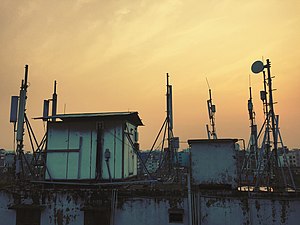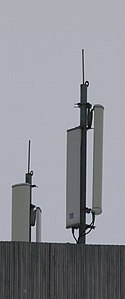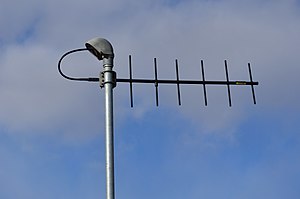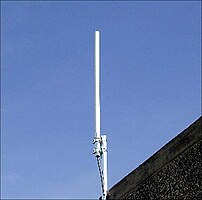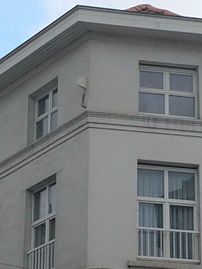Wikiproject Belgium/Infrastructure/BIPT antennas
This page reports some guidelines to map antennas in Belgium. There is also a to do list in order to gather more antennas into OSM. One source that was used for import is the BIPT listing. More details on this import can be found here: Import/Catalogue/ibpt belgium antennas
Guidelines
Antennas are often grouped on a single site, even antennas of different operators. Generally, this site is a ![]() base transceiver station. We only map the site itself (a node at the location of one of the antennas), we don't map the individual antennas.
base transceiver station. We only map the site itself (a node at the location of one of the antennas), we don't map the individual antennas.
The general tags are:
- communication:mobile_phone=yes
- ref:BE:BIPT=*: regulator BIPT's reference code for this site. This value is needed for future synchronization with their inventory.
- ref:BE:Proximus=*, ref:BE:Orange=*, ref:BE:Telenet=*: the reference code for this site in the operator's inventory. The tag is added only if that operator has antennas here.
Depending on the location of the site, there are two different mapping schemes:
Mast, tower or other supporting structure represented as node
We don't create a new node if the antennas are mounted on a structure that is already mapped as a single node, such as man_made=mast, man_made=tower, man_made=water_tower, highway=street_lamp, man_made=chimney, power=tower or highway=street_lamp.
Just add the general tags to the already existing node.
Any other cases
The site can be on a roof, on walls, inside buildings, or even in tunnels, or metro stations.
We create a new node and add telecom=antenna and the general tags. Note that when supporting structures are represented by ways (man_made=water_tower, buildings), we use also this scheme.
If the antenna site is:
- found underground (tunnels, metro stations), add location=underground;
- on a roof, add location=roof;
- inside a building, add location=indoor;
- attached to a wall, add support=wall.
Adding more information
If the site of antennas is:
- disused, add disused:*=* in front of the main tag (man_made=* or telecom=*);
- not visible and you think it never existed there, add ref:BE:BIPT:not_found=yes;
- hidden, add hidden=yes.
Identifying antennas
How can I identify antenna sites?
In cities, most base transceiver stations are located on a rooftop. With top-down imageries, you can often recognize the antennas by their shadows. You can also identify the BTS where the roof is congested with devices and cables (the straight lines).
If it remains difficult to find the site, you can check the planning permissions of the site. You can find these permissions: - for Brussels capital at https://geodata.environnement.brussels/client/view/3a33e35f-6b64-4b28-bb50-5b4c6b7cb29c - for Flanders at https://zendantenneskaart.omgeving.vlaanderen.be/ - for Wallonia at http://geoportail.wallonie.be/catalogue/0d12c026-9882-49b3-a41c-b7e9be4d0692.html
Note that survey on the field remains the best method to confirm the presence of antennas.
What are the different types of antennas?
| Example | Name | Comments |
|---|---|---|
| Sector Antenna | This is the default antenna type, also called "Panel antenna". Size is between 150-280 cm high and the color is white, unless it has been painted to match with the support.
These antennas are usually located on dedicated masts, transmission towers or roofs, but they can also be mounted on walls or hidden inside churches. Usually there are several antennas of this type on the site (typically 3 antennas per operator). | |
| Yagi Antenna | These antennas are usually used inside tunnels or along railways. The "Yagi" antenna itself can also be in a protective tube, making it look like a "cannon".
When found on roofs or poles, they are used as "pickup" for repeater installations: they will catch the signal from a distant site to "reinject" it inside a tunnel or a building.
| |
| Omnidirectional Antenna | Also called "stick", these antennas are made of a cylinder with size is 20-200 cm. Color is white, unless it has been painted to match with a support.
Big omnidirectional ("omni") antennas are not common, but small "omni" (size 20-60 cm) are sometimes used for microcells (local coverage, urban) or indoor sites. | |
| Sharkfin Antenna | Directionnal antenna, typically used in stations (metro, railway) and Indoor sites, sometimes also used in street by microcells for local coverage (urban).
Height is ±25 cm and color is white, unless it has been painted to match with a support (or gray due to age/dirt). The name comes from the appearance of the antenna, which looks like a shark fin. | |
| Mexican Hat Antenna | A specific type of "omni" antenna, exclusively used indoor (inside buildings, stations, hospitals,...). Diameter is ±25 cm and they are always mounted on ceiling. Color is white, unless painted to match with the support (uncommon). |
To do
- contact the regions to get more data on the belgium antennas
- create wiki pages for tags introduced by the import --> ref:BE:BIPT, ref:BE:Proximus, ...
- Extend to GSM-R and Astrid ? (https://www.astrid.be/sites/public/files/2017-10/ASTRID%20A%20tot%20Z%20NL.pdf, https://nl.wikipedia.org/wiki/Terrestrial_Trunked_Radio). Astrid setup is typically 3 distinct parallel antennas: receive, send nearby and send far)
Participants
![]() Vucod (on osm, edits, contrib, heatmap, chngset com.)
Vucod (on osm, edits, contrib, heatmap, chngset com.)
